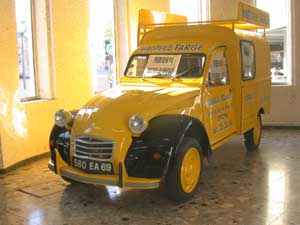
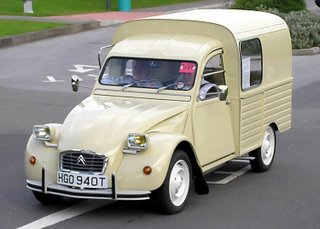
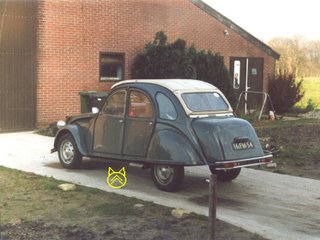
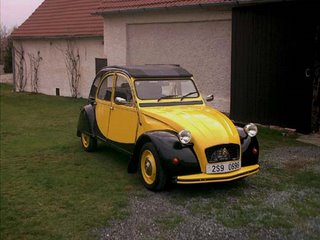
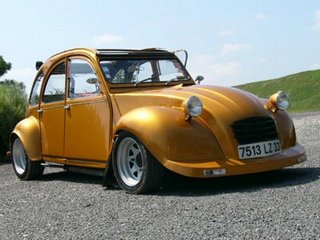
The Citroën 2CV (French: deux chevaux, literally "two horses", from the tax horsepower rating) is an economy car produced by the French automaker Citroën from 1948 to 1990.The 2CV belongs to a very short list of vehicles introduced right after World War II that remained relevant and competitive for many decades - in the case of the 2CV, 42 years.
Pierre Boulanger's early 1930s design brief - said by some to be astonishingly radical for the time - was for a low-priced, rugged "umbrella on four wheels" that would enable two peasants to drive 100 kg of farm goods to market at 60 km/h, in clogs and across muddy unpaved roads if necessary. France at that time had a very large rural population, who had not yet adopted the automobile due to cost. The car would use no more than 3 litres of gasoline to travel 100 km. Most famously, it would be able to drive across a ploughed field without breaking the eggs it was carrying. Boulanger later also had the roof raised to allow
him to drive while wearing a hat.During the German occupation of France during World War II, Michelin (Citroën's main shareholder) and Citroën managers decided to hide the TPV project from the Nazis, fearing some military application. Several TPVs were buried at secret locations, one was disguised as a pickup, and the others were destroyed, and Boulanger had the next six years to think about more improvements. Until 1994, when three TPVs were discovered in a barn, it was believed that only two prototypes had survived. As of 2003, five TPVs are known. For long it was believed that the project was so well hidden that the all the prototypes were lost at the end of the war (in fact it seems that none of the hidden TPVs was lost after the War, but in the 1950s an internal memo ordered them to be scrapped. The surviving TPVs were, in fact, hidden from the top management by some workers who were sensitive to their historical value).
After the war, internal reports at Citroën showed that producing the TPV would not be economically viable, given the rising cost of aluminium in the post-war economy. A decision was made to replace most of the aluminium parts with steel parts. Other changes were made, the most notable being an air-cooled engine, new seats and a restyling of the body by Flaminio Bertoni. It took three years for Citroën to rework the TPV and the car was nicknamed "Toujours Pas Vue" (Still Not Seen) by the press.Citroën finally unveiled the car at the Paris Salon in 1948. The car on display was nearly identical to the type A version that would be sold next year, but lacked an electric starter: the addition of this one was decided the day before the opening of the Salon of Paris. It was enormously criticized. In spite of that, it had a great impact on low-income population.
It was laughed at by journalists, probably because Citroën had launched the car without any press advertising. Boris Vian described the car as an "aberration roulante" (rolling aberration) and the car was qualified as a "Spartan car" or a "sardine can" by many. History has confirmed that the car was charming in a lot of people's views, and a revolution in consumer transportation, at least on the French market.
The 2CV was a great commercial success: within months of it going on sale, there was a three-year waiting list. The waiting list was soon increased to five years. At that time a second-hand 2CV was more expensive than a new one because the buyer did not have to wait. Production was increased from four units per day in 1949 to 400 units per day in 1950. Some of the early models were built at Citroën's plant in Slough, England but the 2CV sold poorly in Great Britain. Expecting to boost sales, Citroën introduced a coupé version called the Bijou that was briefly produced at Slough.
Pierre Boulanger's early 1930s design brief - said by some to be astonishingly radical for the time - was for a low-priced, rugged "umbrella on four wheels" that would enable two peasants to drive 100 kg of farm goods to market at 60 km/h, in clogs and across muddy unpaved roads if necessary. France at that time had a very large rural population, who had not yet adopted the automobile due to cost. The car would use no more than 3 litres of gasoline to travel 100 km. Most famously, it would be able to drive across a ploughed field without breaking the eggs it was carrying. Boulanger later also had the roof raised to allow
him to drive while wearing a hat.During the German occupation of France during World War II, Michelin (Citroën's main shareholder) and Citroën managers decided to hide the TPV project from the Nazis, fearing some military application. Several TPVs were buried at secret locations, one was disguised as a pickup, and the others were destroyed, and Boulanger had the next six years to think about more improvements. Until 1994, when three TPVs were discovered in a barn, it was believed that only two prototypes had survived. As of 2003, five TPVs are known. For long it was believed that the project was so well hidden that the all the prototypes were lost at the end of the war (in fact it seems that none of the hidden TPVs was lost after the War, but in the 1950s an internal memo ordered them to be scrapped. The surviving TPVs were, in fact, hidden from the top management by some workers who were sensitive to their historical value).
After the war, internal reports at Citroën showed that producing the TPV would not be economically viable, given the rising cost of aluminium in the post-war economy. A decision was made to replace most of the aluminium parts with steel parts. Other changes were made, the most notable being an air-cooled engine, new seats and a restyling of the body by Flaminio Bertoni. It took three years for Citroën to rework the TPV and the car was nicknamed "Toujours Pas Vue" (Still Not Seen) by the press.Citroën finally unveiled the car at the Paris Salon in 1948. The car on display was nearly identical to the type A version that would be sold next year, but lacked an electric starter: the addition of this one was decided the day before the opening of the Salon of Paris. It was enormously criticized. In spite of that, it had a great impact on low-income population.
It was laughed at by journalists, probably because Citroën had launched the car without any press advertising. Boris Vian described the car as an "aberration roulante" (rolling aberration) and the car was qualified as a "Spartan car" or a "sardine can" by many. History has confirmed that the car was charming in a lot of people's views, and a revolution in consumer transportation, at least on the French market.
The 2CV was a great commercial success: within months of it going on sale, there was a three-year waiting list. The waiting list was soon increased to five years. At that time a second-hand 2CV was more expensive than a new one because the buyer did not have to wait. Production was increased from four units per day in 1949 to 400 units per day in 1950. Some of the early models were built at Citroën's plant in Slough, England but the 2CV sold poorly in Great Britain. Expecting to boost sales, Citroën introduced a coupé version called the Bijou that was briefly produced at Slough.
No comments:
Post a Comment